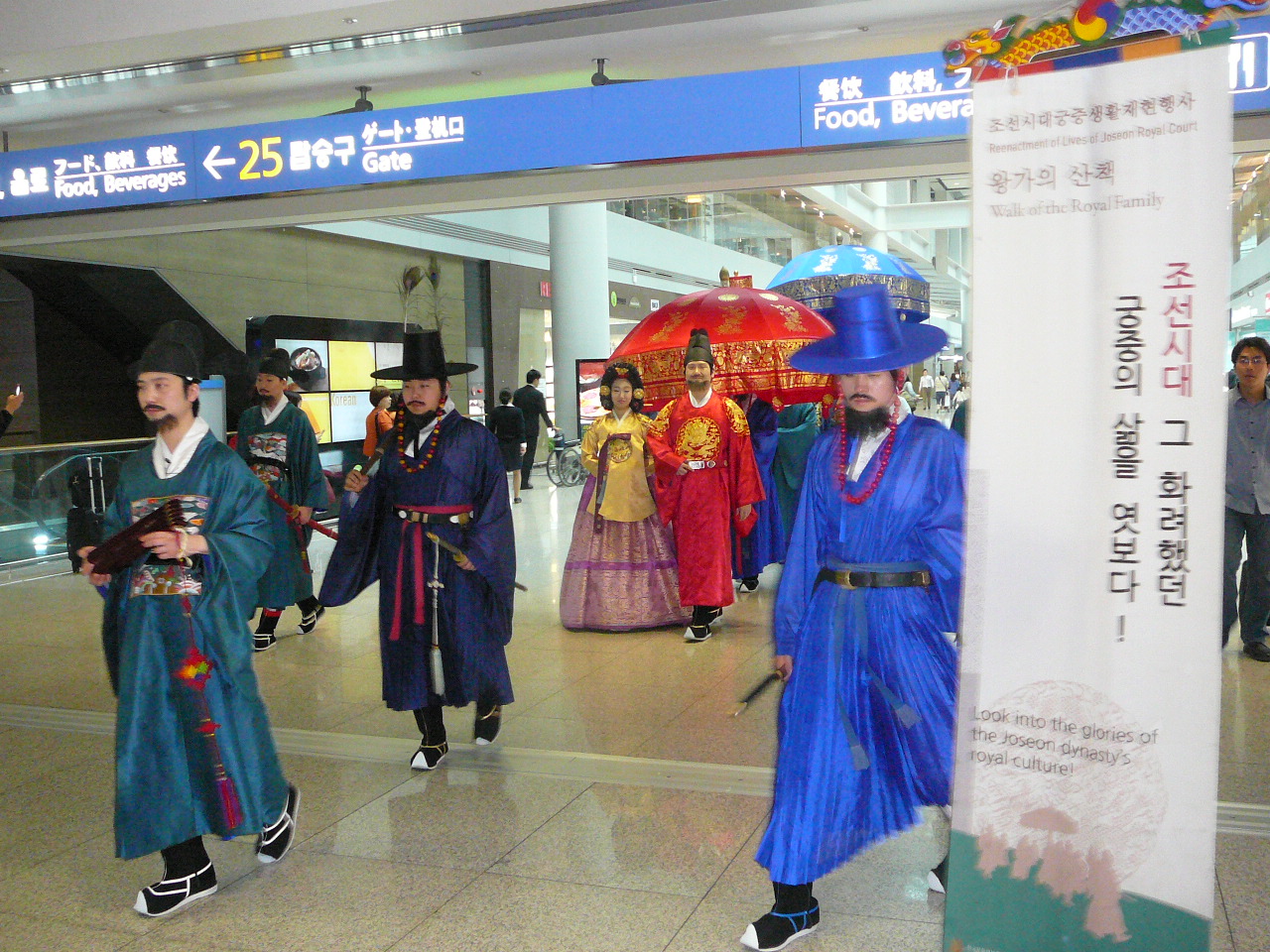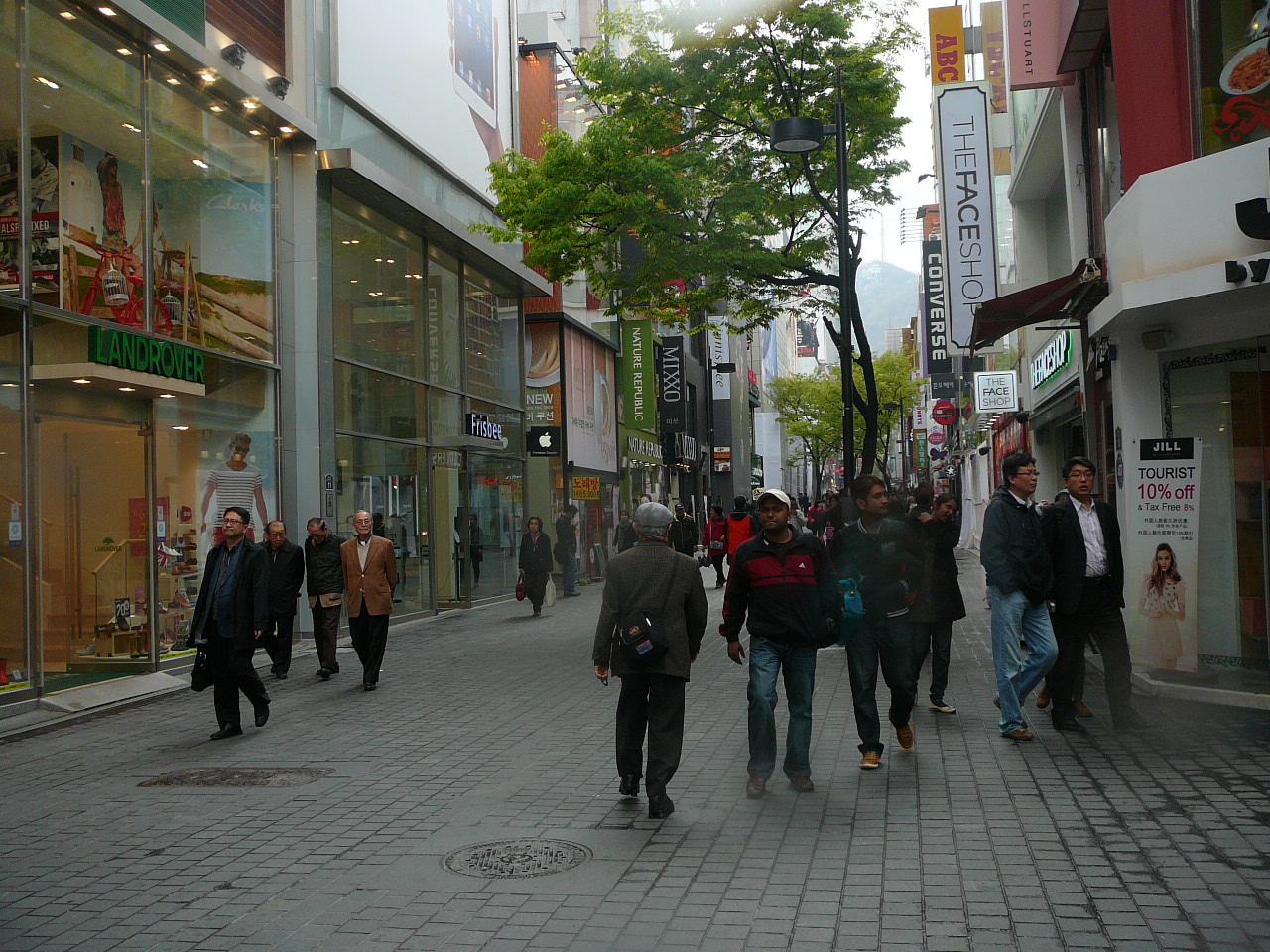We did not want to waste an opportunity for further blog material, and we needed to do something culturally meaningful for Sarah to legitimately count South Korea as Country # 38. We had earlier decided to take a train and subway into downtown Seoul and do a few things. We even found on the Internet someone's excellent step-by-step list of what to do in Seoul on such a layover.
 |
| Gwanghwamun Gate and the Palace Wall at Gyeongbokgung Palace |
We're not going to lie and tell you that this was the most fun day ever. Or that we never get tired during our whirlwind adventures. The truth is, we were tired and grumpy. Really grumpy. Also, the temperature was in the high 40's F and it was pouring down rain. Quite a body shock after 100 F every day in Cambodia, even if we do live in Seattle.
Oh, and the first ATM machine we tried appeared to deduct cash from our bank account without actually giving us the cash. But we called Bank of America and got that straightened out.
The first part of our city journey wasn't so bad. After briefly considering the un-us-like option of an organized tour, we bought our Airport Express tickets and boarded the train.
 |
| The first interior gate at Gyeongbokgung Palace (spelling bee later) |
We met several nice Koreans along the way. One woman helped us figure out which direction to go at the station platform. Another woman gave us her fold-up subway map. A nice man practiced his English with us, and said good things about us for having done the volunteer thing. We were off to a good start.
We made our way to Gyeongbokgung Palace, our first stop, relatively easily. The subway station is close to the palace grounds. We bought our tickets and started walking around. The rain was cold, but it wasn't bothering us too much at this point, since the palace's history, layout and buildings were stimulating.
The palace was built in 1395. It was destroyed by the Japanese invasion of 1592, and languished for almost 300 years before being rebuilt in 1867. The grounds reminded us of the Forbidden City palace in Beijing, China, near Tiananmen Square.
The first room we looked into was called Sajeongjeon. Per the pamphlet we received, this is "the hall where the king should think deeply before deciding what is right or wrong." We think everyone's house should have such a room. We know that not having one is the only reason we sometimes fail to do the right thing.
 |
| Sarah considers whether jet lag is compatible with deep thinking |
 |
| This is where the king formulated all the really cool ethics |
 |
| Another room with heated floors, for the king to hang out in winter |
Next we visited several rooms that functioned as living quarters and visiting rooms for various members of the royal household. This included the king, the crown prince, the queen dowager (king's mother), the court ladies and the ubiquitous concubines.
 |
| We don't remember which royal family members resided here |
 |
| Visitors (e.g. court ladies) stayed in these side rooms at night |
There were other interesting spaces throughout the grounds:
 |
| Roof detail in a room that housed the king's scientific inventions |
 |
| The king threw formal banquets for foreign envoys at Gyeinghoeru Pavilion |
Wet and tired by this time, we decided to leave the palace and go somewhere to get.....even more wet and tired. But first, we got a glimpse of the Palace Guards on the way out.
The Palace Guards are all incredibly tall, probably 6'6" or so (almost 2 meters). They might get an extra inch or so from their shoes, but not much. We're not sure if they were all that tall in the 1400's, but maybe so. They were well trained to stay in character, with stern, unflinching looks on their faces.
 |
| Is their other job playing for the Korean national basketball team? |
 |
| The man on the right is not to be trifled with |
That same evening, at the Seoul airport, a troupe of Palace Guard wannabees walked up and down the concourse. They clearly did not have The Right Stuff.
 |
| Not tall enough, not mean enough, not BAD enough |
John's next quest was to briefly see part of Cheonggyecheon. This is a San Antonio riverwalk-like stretch of stream and pavement, 20 feet below street level, that runs for 3.5 miles.
We knew it was in the same general area as the palace, but we didn't know if it was 2 or 10 blocks away. We traipsed through the cold, hard rain for a few blocks. After being told several times that it was "just up and to the left", we finally gave up, got back on the subway and proceeded directly to Itinerary Item # 3. This was shopping and/or eating lunch in Myeong-dong. We agreed this would be our last stop.
 |
| We knew there were some interesting places in Myeong-dong, just not here |
Myeong-dong is a shopping area with Western brands, certainly not very traditionally Korean. We had hoped to find some trendy restaurant for lunch. We had difficulty finding what we were looking for, even with a map app and some restaurants in mind. Walking around, all we could see were hole-in-the-wall eateries that looked likely to cause stomach problems on the long flight home.
Remembering the advice of two guys we met on the subway, we went into a shopping mall to the restaurants on the 6th floor. There we found an authentic spot, where the local office/retail boys and girls were eating. Actually, about 9 girls to every 1 boy.
You had only this option: Large, Medium or Small for a flat round pan full of chicken, vegetables, spices and sauce. And some rice. We chose, correctly, Small. It was pretty good, and indeed spicy. Life was getting better.
On the same floor as the lunch spot, John discovered something that really lightened our mood. This is apropos of nothing, other than it was really funny to see it in Korea.
 |
| Elvis and Marilyn now live in the Men's room in Myeong-dong |
Elvis and Marilyn must have hoped for something better in their next incarnation. Elvis should definitely leave this building.



































